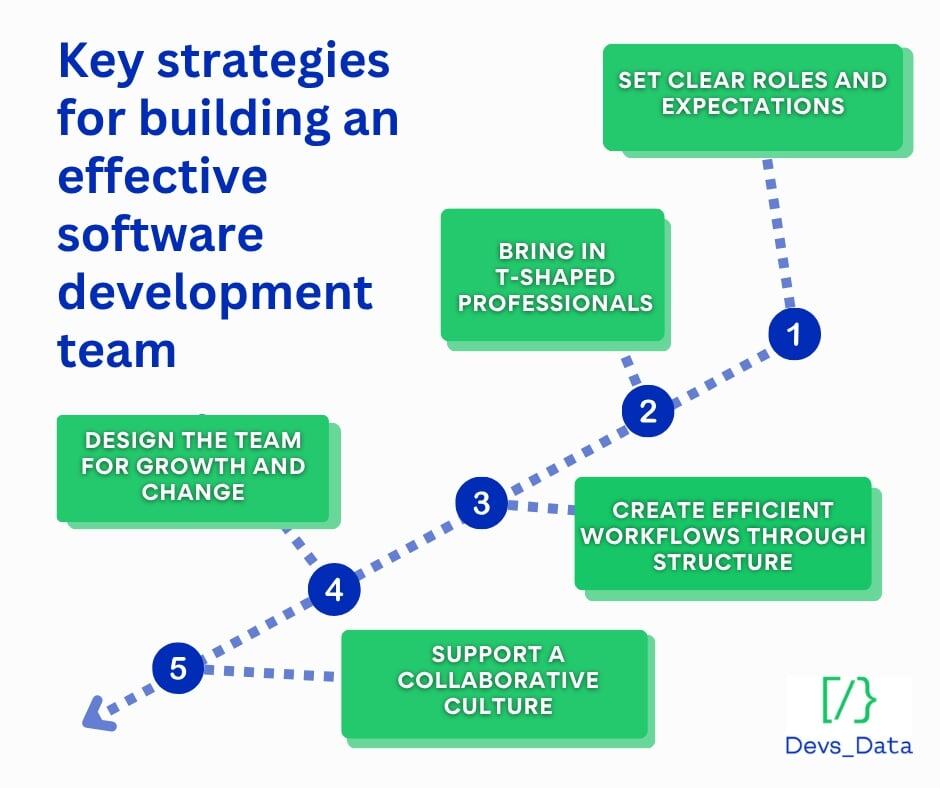


Are your software development teams truly reaching their full potential?
Many teams are not, and one of the main reasons is a lack of structure and clarity. Nearly 50% of employees across all sectors report that they do not fully understand what is expected of them. This goes beyond formal job descriptions. In the fast-moving environment of a growing organization, many are unsure where their responsibilities begin and end or how their work connects to the bigger picture. This kind of uncertainty can quietly slow progress, weaken collaboration, and limit results.
“According to Effectory, employees who experience role clarity are 53% more efficient and 27% more effective at work than those with role ambiguity. Additionally, teams with well-defined structures can experience up to a 25% improvement in overall performance.”
Role clarity means knowing exactly what your responsibilities are, where your work starts and ends, and how it connects to the broader goals of the team. All of the findings point to the same conclusion: without this clarity and a well-structured environment, even experienced teams struggle to perform at their best.
In this article, we explore the essential roles, team models, and practical strategies that help you build and support a well-structured software development team. Whether you’re forming a new team or optimizing an existing one, understanding how structure impacts outcomes can help you create a high-performing team that consistently delivers value.
In a well-structured software development team, each member contributes to a specific part of the project, covering areas like product direction, design, implementation, testing, and quality control. Agile teams, in particular, rely on clearly defined responsibilities and collaborative workflows to keep progress steady and aligned with user needs. Many of the roles described below reflect the structure of Scrum teams, where responsibilities are distributed across cross-functional members working in short, iterative cycles. This approach helps reduce confusion, improve communication, and support faster delivery. Below are the main roles found in an effective software development team:
The product owner is responsible for the tactical implementation of the product vision, acting as the voice of the customer within the development team. They manage the product backlog, break down requirements into actionable user stories, and prioritize tasks to ensure that the most valuable features are delivered first. The product owner also makes quick decisions about trade-offs between scope, quality, and timelines, often collaborating closely with the product manager. Their day-to-day involvement in sprint planning and review sessions helps ensure that the product continuously evolves in alignment with user needs and business goals.
The product manager plays a crucial role in defining the overall product vision and strategy. They are responsible for understanding market needs, customer pain points, and business goals. While the product owner focuses on guiding the team through day-to-day priorities during development, the product manager takes a broader view by shaping the long-term direction of the product. Product managers work closely with stakeholders to prioritize features and ensure that the product roadmap aligns with the overall business strategy. They continuously evaluate the product’s progress, manage expectations, and make necessary adjustments to support its success in the market. A product manager must possess strong communication skills to serve as a link between the technical team and business stakeholders.
The software development manager focuses on overseeing the technical team and making sure the development process runs efficiently. They are responsible for creating an environment where engineers can do their best work, offering guidance, resolving blockers, and managing timelines and resources. In this role, they collaborate closely with both the product owner and product manager to align technical execution with product priorities and strategy. While the product roles define what needs to be built and why, the software development manager focuses on how and when it gets built. They also serve as a communication link between the engineering team and upper management, providing updates on progress and technical needs. In addition to technical expertise, they need strong leadership and people skills to manage the team’s dynamics.
The software architect is responsible for the high-level design and technical vision of the product. They make key decisions about the software’s structure, coding standards, technology stack, and scalability. Software architects must anticipate potential challenges and design the product to be scalable, maintainable, and secure. They work closely with the engineering team and stakeholders to ensure the technical foundation aligns with business requirements. The architect’s decisions are fundamental to the product’s long-term success, and they often provide the guidance needed to solve complex technical problems.
Software developers are the core members of the development team, responsible for building and maintaining the product’s code. Developers write and deploy the software’s features, working closely with the product owner and software architect to ensure that the product meets user requirements and adheres to technical standards. Developers often specialize in specific programming languages, frameworks, or platforms, bringing unique expertise to the team. Due to their experience, coders generally fall into three categories: Junior developers (with 1-3 years of experience), Middle developers (with 3-5 years), and Senior developers (with 7-10+). Each rank brings different levels of expertise to the team, from learning and executing basic tasks to handling complex coding challenges and leading technical initiatives. In addition to technical proficiency, developers must be problem-solvers who can debug and optimize the code to ensure it runs efficiently and effectively.
UX/UI designers are responsible for creating an intuitive and visually appealing user experience. They focus on understanding the needs and behaviors of the target audience, conducting user research, and testing to ensure the product is easy to use. The UX designer works on the layout, navigation, and interaction design, while the UI designer focuses on the visual elements like color schemes, typography, and iconography. Together, they ensure the user’s journey through the software is engaging and enjoyable. UX/UI designers collaborate closely with developers to ensure the design is implemented accurately and provides a positive user experience.
The team or technical lead is responsible for guiding the project’s technical execution. They focus on architecture, code quality, and hands-on problem-solving within the development team. While the product owner defines what needs to be built and prioritizes features, the technical lead focuses on how the solution is designed and implemented. They review code, make architectural decisions, and help the team apply best practices. Unlike the software development manager, who handles people management and process coordination, the technical lead is more involved in the day-to-day technical details. They also mentor less experienced developers and support the team in staying aligned with technical goals and delivery timelines.
The quality assurance (QA) engineer plays a critical role in maintaining the software’s quality by identifying and resolving bugs before releasing the product. QA engineers write and execute test cases to validate that the software performs as expected across different environments and use cases. They test for functionality, performance, security, and compatibility, ensuring the product meets all requirements. QA engineers also collaborate with developers to identify areas for improvement and offer suggestions for optimizing code. Their attention to detail is essential to delivering a high-quality, bug-free product.
The business analyst bridges the business stakeholders and the development team, making sure the product aligns with business objectives and user needs. They gather, analyze, and document requirements, helping define the project’s scope and translating it into clear technical specifications. While the product owner prioritizes features and maintains the product backlog, the business analyst supports that work by detailing requirements and validating that solutions meet business expectations. They also help manage change requests, identify potential risks, and ensure the final product aligns with both client goals and industry standards. Their role is especially important in turning business ideas into actionable development tasks.
The scrum master plays a key role in facilitating the agile development process and making sure the team adheres to Scrum principles. They remove obstacles that slow progress and help team members stay focused and productive. The scrum master also leads key ceremonies such as daily standups, sprint planning, and reviews, supporting clear communication and collaboration. Their focus is on improving team dynamics, encouraging continuous improvement, and maintaining a sustainable pace of work. In some organizations or under different Agile frameworks, this role may be referred to as an Agile Coach, with responsibilities that extend beyond a single team. Regardless of the title, the core function is to guide teams in applying Agile practices effectively.
Testers are responsible for ensuring the product’s functionality, performance, and reliability. They perform manual or automated tests to detect defects and ensure the software behaves as expected under different conditions. Testers work closely with QA engineers and developers to track issues and verify that bugs are resolved. They also assess the product’s usability and identify potential user experience issues. Testers’ work is critical to preventing defects from reaching end users and ensuring that the product delivers a consistent and high-quality experience.
| Role | Primary responsibilities |
|---|---|
| Product Owner | Translates product vision into backlog items and prioritizes tasks to deliver user value efficiently. Works closely with developers to guide feature development and clarify requirements. |
| Product Manager | Defines the product roadmap based on business strategy and market research. Aligns stakeholders and ensures development meets business goals. |
| Software Development Manager | Oversees the development team’s productivity and well-being. Handles team management, mentorship, and project coordination. |
| Software Architect | Designs the software’s technical framework and long-term structure. Chooses technologies and sets architectural standards. |
| Software Developer | Builds, tests, and maintains software features. Collaborates across roles to turn specifications into functional code. |
| UX/UI Designer | Designs intuitive, user-friendly interfaces based on research and usability principles. Works with developers to implement design accurately. |
| Team Lead / Technical Lead | Provides hands-on technical leadership and solves complex coding challenges. Ensures development stays aligned with coding standards and project goals. |
| QA Engineer | Creates and runs test cases to identify and document bugs. Works with developers to maintain high product quality. |
| Business Analyst | Gathers requirements from stakeholders and translates them into actionable development tasks. Bridges the gap between business needs and technical execution. |
| Scrum Master | Facilitates Agile ceremonies, removes obstacles, and promotes team efficiency. Encourages continuous improvement in development workflows. |
| Tester | Performs manual or automated testing to verify software functionality and usability. Reports issues and confirms fixes before release. |
While each role has a defined area of focus, effective software development depends on close collaboration between them. For example, the product owner works with the business analyst to refine requirements and with the developers to clarify priorities during implementation. The product manager and software development manager align business goals with team capacity and timelines. Architects and technical leads ensure that proposed features are feasible and scalable, while QA engineers and testers collaborate with developers to maintain quality. These intersections help bridge strategic goals with day-to-day execution, allowing the team to deliver meaningful, well-functioning products.
Do you have IT recruitment needs?
Building a strong software development team goes beyond hiring talented individuals. The structure of the team, the clarity of roles, and the overall approach to collaboration all influence how effectively the team performs. A well-organized and thoughtfully supported team can improve speed, quality, adaptability, and long-term product success.
Below are several strategies to help guide the process of building and supporting an effective software team.
From the start, each member of the development team should have a clear understanding of their specific responsibilities, the boundaries of their role, and how their work contributes to the team’s goals. This includes knowing who owns which decisions, who to turn to for input, and how handoffs should occur between functions like design, engineering, and QA. While the focus is on the immediate team structure, these roles should also be aligned with the expectations of the broader organization to support smooth collaboration with product management, leadership, and other departments. This clarity helps prevent duplicated efforts, delays, and confusion and creates a more accountable and efficient workflow.
A recent study by Wrike, a project management software company, found that 73% of high-performing teams have clear, well-defined goals, emphasizing how critical communication and goal-setting are for team success. This illustrates how the right team structure can directly contribute to achieving better outcomes in software development.
T-shaped team members have deep expertise in one area and working knowledge of others. This combination not only supports cross-functional collaboration but also increases substitutability within the team. For example, a developer who understands basic design principles can step in to support a designer during handoff reviews, while a QA tester familiar with development workflows can help identify issues earlier in the process. These overlaps reduce bottlenecks, allow for smoother transitions when someone is unavailable, and make the team more adaptable to shifting needs.
When a team follows well-defined development processes, such as code reviews, version control, sprint planning, and automated testing, daily work becomes more predictable and easier to manage. These workflows help developers, designers, product managers, and QA engineers stay coordinated, reducing miscommunication and delays. For example, using pull requests and CI/CD pipelines can streamline code deployment, while structured sprint rituals like backlog grooming and retrospectives help keep priorities clear. This kind of process-driven structure allows the team to deliver features consistently, resolve issues quickly, and maintain alignment across disciplines.
A good team structure also supports future changes. As a product expands or shifts direction, the team may need to grow, reconfigure roles, or add new capabilities. This might involve hiring specialists, adjusting responsibilities, or increasing capacity in areas such as testing, infrastructure, or support. Creating a resource staffing plan that outlines potential future roles, timing, and skill requirements helps prepare for growth in a structured way. Building in this kind of flexibility early on makes the team more resilient and better equipped to adapt when priorities change.
Technical structure matters, but culture plays just as important a role. When team members feel supported, they are more likely to contribute ideas, stay engaged, and work through challenges together. Regular feedback, recognition for work well done, and shared goals help build trust and create a positive atmosphere. Encouraging collaboration across roles helps the team learn from each other and maintain a shared sense of purpose.

Building a strong team is only part of the equation. To know whether your structure is actually supporting your goals, it’s essential to track key performance indicators (KPIs) that reflect both technical output and team health. These metrics should be aligned with the team’s specific objectives, such as feature delivery speed, code quality, or collaboration, and tied to broader organizational goals. Monitoring the right data helps evaluate how well the structure supports performance, uncovers areas for improvement, and reinforces the larger goal of creating a team that can grow, adapt, and deliver lasting value.
Velocity measures how much work a team completes in a given sprint, typically using story points. Tracking velocity over time helps identify whether the team is improving, maintaining consistency, or struggling with scope estimation and capacity planning.
Lead time refers to the total time it takes for a feature or task to move from idea to production. Cycle time measures how long a task spends in active development. Together, these metrics provide insight into workflow efficiency and can highlight process issues that slow down delivery.
Bug rate helps gauge the quality of code being delivered. A high number of defects may indicate a need for improved testing or code reviews. Deployment frequency indicates how often the team delivers updates to production. More frequent, stable deployments often reflect a healthy, well-coordinated team.
Technical metrics alone don’t capture the full picture. Gathering feedback through short surveys or regular check-ins gives insight into morale, team dynamics, and areas where additional support may be needed. High satisfaction often correlates with better retention and stronger performance.
Together, these KPIs offer a balanced view of productivity, quality, and team health, helping you evaluate whether your team structure is truly supporting long-term success.
Team structure in software development isn’t fixed. It evolves alongside your product. Each stage of the product lifecycle brings new challenges, requiring different skills, workflows, and levels of specialization. Understanding how a team’s needs change over time helps you plan more effectively and scale with purpose.
At the early stage of product development, teams are usually small and composed of generalists. These individuals wear multiple hats, quickly iterate on features, and adapt to changing priorities. Speed and flexibility take priority over formal roles and long-term planning.
As the product gains traction, the team begins to grow. Specialist roles emerge, including frontend and backend developers, QA engineers, and UX designers, each focused on improving quality and depth in their domain. This shift enables more structured workflows and better support for increasingly complex feature sets.
At scale the team structure becomes more formalized to support complexity and cross-functional collaboration. Leadership roles such as engineering managers and technical leads provide strategic guidance, while QA specialists and product analysts contribute to delivery, reliability, and performance. As more teams work in parallel, clear ownership, coordination across squads or departments, and well-defined processes become essential.
Applying Agile at scale through frameworks such as SAFe or LeSS can help maintain alignment, adaptability, and speed across large organizations. Recognizing how structure must evolve with the product lifecycle ensures the team continues to meet current needs and remains prepared for future growth.
When structuring a software development team, it’s important to select a team model that fits the project’s specific needs. Three common structures are generalist teams, specialist teams, and hybrid teams, each with distinct advantages and challenges. Let’s explore each model in more detail to help you understand which may be the best fit for your development process:
| Team structure | Description | Pros | Cons |
|---|---|---|---|
| Generalist team | A generalist team comprises individuals with a broad skill set who can handle various tasks across the software development process. Depending on the project’s needs, members of this team may take on roles in coding, testing, design, and project management. |
– Cost-effective due to multitasking roles – Flexible and adaptable to shifting project needs – Easier to manage in smaller teams |
– May lack deep expertise in specialized areas – Risk of team members becoming overburdened with responsibilities – Potential decline in quality for complex technical tasks |
| A specialist team | A specialist team is made up of individuals with deep expertise in specific areas of software development, such as back-end development, front-end development, UX/UI design, or quality assurance. |
– High expertise and quality in specialized tasks – Efficient in areas requiring deep technical knowledge – Clear focus on specific domains (e.g., frontend, back-end, QA) |
– May require more resources and be less cost-effective – Lack of flexibility and adaptability to changing project needs – Communication challenges due to expertise being divided among team members |
| Hybrid team | A hybrid team combines generalists and specialists, combining the depth of expertise of specialists with the flexibility and adaptability of generalists. This structure allows for high-quality outputs while ensuring the team can shift gears when necessary. |
– Combines the flexibility of generalists with the deep expertise of specialists – High-quality work in specialized areas with improved collaboration and communication – Adapts well to changing needs and diverse project requirements |
– Complex management due to balancing roles – Potential role ambiguity if responsibilities are not clearly defined – Risk of inefficiency if coordination between generalists and specialists is not smooth |
This comparison shows that team composition should reflect the context of your product and organization. Generalist teams work well in early-stage environments where flexibility and multitasking are essential. Specialist teams are better suited for projects that require deep technical knowledge and a high level of precision. Hybrid teams offer a middle ground by combining broad capability with focused expertise. Selecting the right structure helps teams stay productive, adapt to change, and deliver quality outcomes. It’s an important decision that affects collaboration, scalability, and the overall success of the development process.
How you structure your development team often depends on the methodology you use. Whether it’s Agile, Waterfall, or a mix of both, the approach you take shapes how your team works together, communicates, and delivers results.
Agile is the go-to choice for most modern teams. It’s flexible, fast-moving, and built for change. With Agile frameworks like Scrum or Kanban, work is broken down into smaller chunks delivered in short cycles. Teams meet regularly, adapt as needed, and continually improve.
This method typically involves cross-functional teams, including developers, designers, QA, and a product owner, who collaborate closely. Everyone stays aligned on goals, and feedback is provided frequently.
Why it works:
Agile is ideal for fast-paced environments, especially when requirements aren’t fully clear from the start or need to change quickly (think startups, SaaS, and digital products).
Waterfall is the more traditional route. Each phase (like design, development, testing) happens one after another. Everything is planned upfront, and there’s less flexibility to make changes later.
It makes sense for projects with a well-defined scope, strict timelines, or compliance requirements, such as government work or large-scale enterprise systems.
What to expect:
Sometimes, the best fit is a combination of approaches. A hybrid model blends Agile’s flexibility with Waterfall’s structure, for example, starting with a detailed planning phase and then switching to Agile sprints. In tech-heavy organizations, DevOps practices may also come into play, bringing development and operations closer together to speed up releases and improve reliability.
The methodology you choose affects:
There’s no one-size-fits-all answer. The best approach depends on your goals, your team, and the kind of product you’re building. The key is to pick a model that supports collaboration, delivers value early, and keeps your team moving forward together.
Website: www.devsdata.com
Team size: ~60 employees
Founded: 2016
Headquarters: Brooklyn, NY, and Warsaw, Poland
DevsData LLC is a leading IT recruitment and software development company offering a dual approach to meet businesses’ unique needs. With over 9 years of industry experience, the company provides recruitment solutions and software development outsourcing, ensuring clients have access to top-tier talent and high-quality, scalable solutions. The company has a 5/5 client satisfaction rating on Clutch and GoodFirms, further supported by positive public testimonials.
DevsData LLC excels in IT recruitment, helping companies find the right talent for their software development teams. With a database of over 65000 professionals and a government-approved recruitment license, their process is thorough and efficient. The recruitment team, consisting of 40 experienced recruiters based in the US and Europe, conducts in-depth 90-minute technical interviews and comprehensive skills assessments to ensure clients are matched with highly qualified candidates tailored to their project needs. By leveraging this expertise, they can help clients find highly qualified candidates tailored to their specific project needs, whether expanding an existing team or building a new one.
Alongside recruitment, DevsData LLC offers software development outsourcing services. The company has a proven track record with over 100 completed projects for more than 80 clients, including web development and complex backend systems. DevsData LLC works with a diverse team of engineers from Europe, North America, and Latin America, including Google-level engineers and senior contractors, ensuring that experienced professionals handle each project.
DevsData LLC has collaborated with prominent clients like Johnson & Johnson, ZIM, and BCG, as well as innovative startups from the US and Israel, bringing expertise in emerging technologies such as AI, machine learning, and data science. Their ability to create scalable, secure, and user-friendly systems has improved efficiency, cost savings, and enhanced business operations for their clients.
An example of its success in building an ideal team can be seen in its partnership with a Norwegian SaaS company, Memory AS. DevsData LLC supported the client in assembling a skilled, distributed development team by hiring 2 senior Ruby developers under a tight deadline. With a clear focus on role definition, technical alignment, and time zone compatibility, the recruitment process was completed within 6 weeks. This allowed Memory AS to stay on track with AI-related project milestones and demonstrated how a structured, well-planned team setup can directly support product delivery and long-term goals.
Do you have IT recruitment needs?
Whether you’re looking to build a software development team or outsource your software projects, DevsData LLC offers a personalized, flexible approach that reduces overhead costs while maintaining high-quality results. Schedule a consultation to discuss your specific needs and find the right solution for your business.
Building an effective software development team requires more than hiring skilled professionals. The way a team is structured, how roles are defined, and how people collaborate all have a direct impact on performance, quality, and long-term results. Role clarity plays a central part in this. When each team member understands their responsibilities, decision-making authority, and how their work connects with others, the team is better equipped to deliver consistent, high-quality outcomes.
Beyond individual roles, two key elements influence a team’s success. The first is the overall approach to development, whether the team follows Agile methodologies like Scrum or Kanban, a more traditional Waterfall model, or a hybrid setup. This approach shapes how the team communicates, plans work, tracks progress, and handles change. The second is the team’s ability to adapt its structure. As projects evolve, new roles may be introduced and responsibilities redefined to stay aligned with shifting priorities and business goals.
DevsData LLC excels in building high-performing software development teams, ensuring roles are clearly defined, communication is strong, and flexibility is prioritized. Whether working with startups or large enterprises, the company helps clients expand their teams with top-tier talent. DevsData LLC delivers innovative solutions on time and within budget by fostering collaboration and adaptability, ensuring projects exceed expectations while efficiently scaling teams as needed.
For more information on how DevsData LLC can support your recruitment or software development needs, contact them at general@devsdata.com or visit their website at www.devsdata.com.
Frequently asked questions (FAQ)
DevsData – your premium technology partner
DevsData is a boutique tech recruitment and software agency. Develop your software project with veteran engineers or scale up an in-house tech team of developers with relevant industry experience.
Free consultation with a software expert
🎧 Schedule a meeting
FEATURED IN


DevsData LLC is truly exceptional – their backend developers are some of the best I’ve ever worked with.”
Nicholas Johnson
Mentor at YC, serial entrepreneur


 Build your project with our veteran developers
Build your project with our veteran developers
 Explore the benefits of technology recruitment and tailor-made software
Explore the benefits of technology recruitment and tailor-made software
 Learn how to source skilled and experienced software developers
Learn how to source skilled and experienced software developers




Categories: Big data, data analytics | Software and technology | IT recruitment blog | IT in Poland | Content hub (blog)
